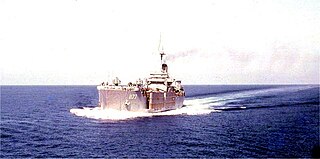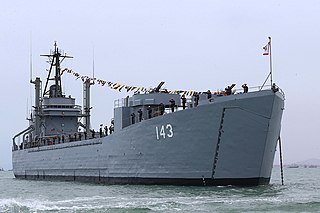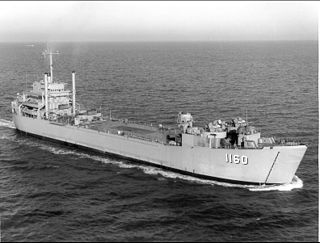
USS Trenton (LPD-14), an Austin-class amphibious transport dock, was the third ship of the United States Navy to be named for the capital of New Jersey. In 2007, it was sold to the Indian Navy and renamed INS Jalashwa.

USS Vermilion (AKA-107/LKA-107), was a Tolland-class attack cargo ship of the United States Navy, named after a parish in southern Louisiana and a county in eastern Illinois. She served as a commissioned ship for 25 years and 9 months.

USS Ashland (LSD-1) was the lead ship of her class—the first dock landing ship of the United States Navy. She was the first Navy ship to be named for Ashland, the estate of Henry Clay, in Lexington, Kentucky.
USS York County (LST-1175) was a De Soto County-class tank landing ship built for the United States Navy during the late 1950s. The lead ship of her class of seven, she was named after counties in Maine, Nebraska, Pennsylvania, South Carolina, and Virginia, she was the only U.S. Naval vessel to bear the name.

USS Wood County (LST-1178) was a De Soto County-class tank landing ship built for the United States Navy during the late 1950s. Named after counties in Ohio, Texas, West Virginia, and Wisconsin, she was the only U.S. Naval vessel to bear the name.

USS Middlesex County (LST-983) was an LST-542-class tank landing ship built for the United States Navy during World War II. Named after counties in Connecticut, Massachusetts, New Jersey, and Virginia, she was the only United States Navy vessel to bear the name.

USS Meeker County (LST-980) was an LST-542-class tank landing ship built for the United States Navy during World War II. Like many of her class, she was not named and is properly referred to by her hull designation. Later named after Meeker County, Minnesota, she was the only US Naval vessel to bear the name.

USS Washtenaw County (LST-1166) was a Terrebonne Parish-class tank landing ship in commission in the United States Navy from 1953 to 1973. Named for Washtenaw County, Michigan, she was the only U.S. Navy vessel to bear the name. It is currently derelict. In October 2008, it was reported to be at the southeastern tip of Lord Island on the Columbia River in Rainier, Oregon at 46°07′18″ N 123°00′51″ W next to the Oregon shoreline. It is listed as a derelict vessel by the interagency Derelict Vessel Task Force, and has suffered damage from vandalism and looting between 2005 and 2008. While some had hoped to restore the ship as a museum ship, there is no funding or plan to do so.
USS Terrebonne Parish (LST-1156), originally USS LST-1156, affectionately nicknamed the "T-Bone" by her early crew, was a Terrebonne Parish-class tank landing ship built for the United States Navy in 1952. The lead ship in her class, she was named for Terrebonne Parish, Louisiana, the only U.S. Navy vessel to bear the name. The ship was later transferred to Spain and renamed Velasco (L-11), and was scrapped in 1994.

USS Graham County (LST-1176/AGP-1176) was a De Soto County-class tank landing ship built for the United States Navy during the late 1950s. Named after counties in Arizona, Kansas, and North Carolina, she was the only U.S. Naval vessel to bear the name.

USS Lorain County (LST-1177) was a De Soto County-class tank landing ship built for the United States Navy during the late 1950s. Named after Lorain County, Ohio, she was the only U.S. Naval vessel to bear the name.

USS Barnstable County (LST-1197) was the nineteenth ship of the Newport class of tank landing ships. She was laid down on 19 December 1970 at San Diego, California, by the National Steel and Shipbuilding Corporation and launched on 2 October 1971. She was commissioned on 27 May 1972. The ship was named after Barnstable County, Massachusetts.

USS Fort Mandan (LSD-21) was a Casa Grande-class dock landing ship of the United States Navy, named in honor of Fort Mandan, the encampment at which the Lewis and Clark Expedition wintered in 1804–1805, in what is now North Dakota.

USS Wahkiakum County (LST-1162), previously USS LST-1162, was a United States Navy landing ship tank (LST) in commission from 1953 to 1970, and which then saw non-commissioned Military Sealift Command service as USNS Wahkiakum County (T-LST-1162) from 1972 to 1973.

USS Walworth County (LST-1164), previously USS LST-1164, was a United States Navy landing ship tank (LST) in commission from 1953 to 1971, and which then saw non-commissioned Military Sealift Command service as USNS Walworth County (T-LST-1164) from 1972 to 1973.

USS Washoe County (LST-1165), previously USS LST-1165, was a United States Navy landing ship tank (LST) in commission from 1953 to 1971, and which then saw non-commissioned Military Sealift Command service as USNS Washoe County (T-LST-1165) in 1973.

USS Wexford County (LST-1168), previously USS LST-1168, was a United States Navy landing ship tank (LST) in commission from 1953 to 1971, which saw service in the Atlantic, Caribbean, and Pacific and served in the Vietnam War..

USS Traverse County (LST-1160), previously USS LST-1160, was a United States Navy landing ship tank (LST) in commission from 1953 to 1970, and which then saw non-commissioned Military Sealift Command service as USNS Traverse County (T-LST-1160) from 1972 to 1973.

USS Ruchamkin (APD-89), ex-DE-228, later LPR-89, was a United States Navy high-speed transport in commission from 1945 to 1946, from 1951 to 1957, and from 1961 to 1969. She subsequently served as ARC Córdoba in the Colombian Navy, until 1980; although scrapped, her hull and superstructure were re-erected in a leisure park near Bogotá.

USS Bassett (APD-73), ex-DE-672, was a United States Navy high-speed transport in commission from 1945 to 1946 and from 1950 to 1957.


















